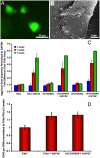Supramolecular design of self-assembling nanofibers for cartilage regeneration
- PMID: 20133666
- PMCID: PMC2840471
- DOI: 10.1073/pnas.0906501107
Supramolecular design of self-assembling nanofibers for cartilage regeneration
Abstract
Molecular and supramolecular design of bioactive biomaterials could have a significant impact on regenerative medicine. Ideal regenerative therapies should be minimally invasive, and thus the notion of self-assembling biomaterials programmed to transform from injectable liquids to solid bioactive structures in tissue is highly attractive for clinical translation. We report here on a coassembly system of peptide amphiphile (PA) molecules designed to form nanofibers for cartilage regeneration by displaying a high density of binding epitopes to transforming growth factor beta-1 (TGFbeta-1). Growth factor release studies showed that passive release of TGFbeta-1 was slower from PA gels containing the growth factor binding sites. In vitro experiments indicate these materials support the survival and promote the chondrogenic differentiation of human mesenchymal stem cells. We also show that these materials can promote regeneration of articular cartilage in a full thickness chondral defect treated with microfracture in a rabbit model with or even without the addition of exogenous growth factor. These results demonstrate the potential of a completely synthetic bioactive biomaterial as a therapy to promote cartilage regeneration.
Conflict of interest statement
The authors declare no conflict of interest.
Figures






Similar articles
-
Transforming Growth Factor β-1 Binding by Peptide Amphiphile Hydrogels.ACS Biomater Sci Eng. 2020 Aug 10;6(8):4551-4560. doi: 10.1021/acsbiomaterials.0c00679. Epub 2020 Jul 8. ACS Biomater Sci Eng. 2020. PMID: 33455189
-
Supramolecular GAG-like Self-Assembled Glycopeptide Nanofibers Induce Chondrogenesis and Cartilage Regeneration.Biomacromolecules. 2016 Feb 8;17(2):679-89. doi: 10.1021/acs.biomac.5b01669. Epub 2016 Jan 13. Biomacromolecules. 2016. PMID: 26716910
-
A tenascin-C mimetic peptide amphiphile nanofiber gel promotes neurite outgrowth and cell migration of neurosphere-derived cells.Acta Biomater. 2016 Jun;37:50-8. doi: 10.1016/j.actbio.2016.04.010. Epub 2016 Apr 7. Acta Biomater. 2016. PMID: 27063496 Free PMC article.
-
Supramolecular self-assembling peptides to deliver bone morphogenetic proteins for skeletal regeneration.Bone. 2020 Dec;141:115565. doi: 10.1016/j.bone.2020.115565. Epub 2020 Jul 31. Bone. 2020. PMID: 32745692 Free PMC article. Review.
-
[Articular cartilage regeneration with synovial mesenchymal stem cells].Clin Calcium. 2011 Jun;21(6):879-89. Clin Calcium. 2011. PMID: 21628803 Review. Japanese.
Cited by
-
Fragmentation and Coagulation in Supramolecular (Co)polymerization Kinetics.ACS Cent Sci. 2016 Apr 27;2(4):232-41. doi: 10.1021/acscentsci.6b00009. Epub 2016 Mar 21. ACS Cent Sci. 2016. PMID: 27163054 Free PMC article.
-
Self-Repair of Structure and Bioactivity in a Supramolecular Nanostructure.Nano Lett. 2018 Nov 14;18(11):6832-6841. doi: 10.1021/acs.nanolett.8b02709. Epub 2018 Oct 31. Nano Lett. 2018. PMID: 30379077 Free PMC article.
-
Multicomponent peptide assemblies.Chem Soc Rev. 2018 May 21;47(10):3659-3720. doi: 10.1039/c8cs00115d. Chem Soc Rev. 2018. PMID: 29697126 Free PMC article. Review.
-
Recapitulating dynamic ECM ligand presentation at biomaterial interfaces: Molecular strategies and biomedical prospects.Exploration (Beijing). 2022 Jan 24;2(1):20210093. doi: 10.1002/EXP.20210093. eCollection 2022 Feb. Exploration (Beijing). 2022. PMID: 37324582 Free PMC article. Review.
-
Regeneration of articular cartilage defects: Therapeutic strategies and perspectives.J Tissue Eng. 2023 Mar 31;14:20417314231164765. doi: 10.1177/20417314231164765. eCollection 2023 Jan-Dec. J Tissue Eng. 2023. PMID: 37025158 Free PMC article. Review.
References
-
- Buckwalter JA, Mankin HJ. Articular cartilage: Degeneration and osteoarthritis, repair, regeneration, and transplantation. Instr Course Lect. 1998;47:487–504. - PubMed
-
- O’Driscoll SW. Current concepts review—The healing and regeneration of articular cartilage. J Bone Joint Surg Am. 1998;80:1795–1812. - PubMed
-
- Hunziker EB. Articular cartilage repair: Basic science and clinical progress. A review of the current status and prospects. Osteoarthr Cartilage. 2002;10:432–463. - PubMed
-
- Jackson DW, Simon TM, Aberman HM. Symptomatic articular cartilage degeneration: The impact in the new millennium. Clin Orthop Relat Res. 2001;391 (Suppl):S14–25. - PubMed
-
- Williams RJ, Harnly HW. Microfracture: Indications, technique, and results. Instr Course Lect. 2007;56:419–428. - PubMed
Publication types
MeSH terms
Substances
Grants and funding
LinkOut - more resources
Full Text Sources
Other Literature Sources

